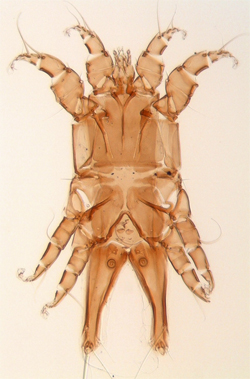Feather mites are useful models for studying speciation due to their high diversity and strong degree of host specialization. However, studies to date have focused on the evolution of higher-level mite taxa while much hidden diversity likely occurs at the level of host genera and species. In this study, the diversity and evolution of feather mites infesting six sympatric seabird species from six genera, breeding in the Cape Verde archipelago, were examined. Thirty-two feather mite morphospecies categorized into 10 genera and three families were reported, of which nine correspond to new, undescribed species. Molecular data corroborated morphological species descriptions, except for two morphologically-cryptic, but genetically distinct mite lineages related to Zachvatkinia oceanodromae and Laminalloptes simplex. Using these communities, a co-structure approach was then applied to test the contribution of ectosymbiont and host factors in driving feather mite evolution. Most seabird species hosted specific and unique feather mite species, even under sympatric conditions, and in general, feather mite species exhibited strong host-driven genetic structure. However, patterns of genetic differentiation were variable. That is, some mite species are more generalist than others and mite lineages/haplotypes can be shared by related seabird species. Interestingly, host-specific mites (e.g., Zachvatkinia spp.) tend to display much higher intra-specific diversity compared to more generalist mites (e.g., Microspalax and Plicatalloptes spp.). Ectosymbiont and host life-history traits that might generate these patterns were discussed, such as host dispersal and breeding behavior and/or mite spatial and trophic specialization. These findings highlight both the vast and largely unrecognized diversity of avian feather mites on seabirds, and the intrinsic complexity of the ecological processes underlying the evolution of these ectosymbionts. informacion[at]ebd.csic.es: Stefan et al (2018) "More Than Meets the Eye": Cryptic diversity and contrasting patterns of host-specificity in feather mites inhabiting seabirds. Front Ecol Evol https://doi.org/10.3389/fevo.2018.00097
https://www.frontiersin.org/articles/10.3389/fevo.2018.00097/full

 Las altas temperaturas están provocando que las lagunas y las marismas de Doñana pierdan agua rápidamente
Las altas temperaturas están provocando que las lagunas y las marismas de Doñana pierdan agua rápidamente




